
USS Galena was a wooden-hulled broadside ironclad built for the United States Navy during the American Civil War. The ship was initially assigned to the North Atlantic Blockading Squadron and supported Union forces during the Peninsula Campaign in 1862. She was damaged during the Battle of Drewry's Bluff because her armor was too thin to prevent Confederate shots from penetrating. Widely regarded as a failure, Galena was reconstructed without most of her armor in 1863 and transferred to the West Gulf Blockading Squadron in 1864. The ship participated in the Battle of Mobile Bay and the subsequent Siege of Fort Morgan in August. She was briefly transferred to the East Gulf Blockading Squadron in September before she was sent to Philadelphia, Pennsylvania for repairs in November.

CSS Oregon was a wooden sidewheel steamer that served as a gunboat in the Confederate States Army during the American Civil War. Built in 1846 for the Mobile Mail Line, she transported mail between New Orleans, Louisiana, and Mobile, Alabama, before the war. In 1861, she was seized by the Governor of Louisiana, Thomas Overton Moore, and served as a blockade runner before being selected for use by the Confederate Army. After transferring men and supplies to Ship Island, she was formally converted into a gunboat and armed with four cannon. Remaining behind on Lake Pontchartrain when many Confederate warships were transferred up the Mississippi River, Oregon served in the Mississippi Sound and Pass Christian areas. She took part in several minor actions involving USS New London, two of which resulted in the Confederates moving into shallow water to avoid close-range action, and the third ending when the Confederate ships abandoned the Pass Christian area. In April 1862, Union pressure confined her and other Confederate ships to Lake Pontchartrain. Later that month, with Union forces closing in on New Orleans, Oregon was sunk as a blockship. Her wreck was removed and destroyed in the early 1870s.

The Battle of Mobile Bay of August 5, 1864, was a naval and land engagement of the American Civil War in which a Union fleet commanded by Rear Admiral David G. Farragut, assisted by a contingent of soldiers, attacked a smaller Confederate fleet led by Admiral Franklin Buchanan and three forts that guarded the entrance to Mobile Bay: Morgan, Gaines and Powell. Farragut's perhaps apocryphal order of "Damn the torpedoes! Four bells. Captain Drayton, go ahead! Jouett, full speed!" became famous in paraphrase, as "Damn the torpedoes, full speed ahead!"

CSS Tennessee was a casemate ironclad ram built for the Confederate Navy during the American Civil War. She served as the flagship of Admiral Franklin Buchanan, commander of the Mobile Squadron, after her commissioning. She was captured in 1864 by the Union Navy during the Battle of Mobile Bay and then participated in the Union's subsequent Siege of Fort Morgan. Tennessee was decommissioned after the war and sold in 1867 for scrap.
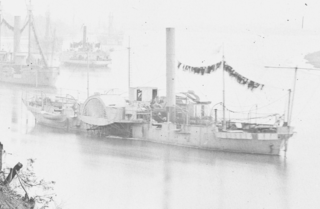
The first USS Miami was a side-wheel steamer, double-ender gunboat in the United States Navy during the American Civil War.

The Confederate blockade runner CSS Florida, was built at Greenpoint, New York in 1859. Considered for service as a gunboat three times during the American Civil War, the vessel was captured by the Union Navy on April 6, 1862. The ship was taken into service by the Union and renamed USS Hendrick Hudson.

CSSSelma was a steamship in the Confederate States Navy during the American Civil War. She served in the Confederate Navy first as Florida, and later as Selma. She was captured by the Union Navy steamer USS Metacomet during the Battle of Mobile Bay. She served as USS Selma until the end of the war, when she was decommissioned and sold for use as a merchant ship.
The CSS Beaufort was an iron-hull gunboat that served in North Carolina and Virginia during the American Civil War. Originally launched as Caledonia at Wilmington, Delaware, in 1854, the ship was owned by James Cathcart Johnston. It saw use as a tugboat on the Dismal Swamp Canal. On July 9, 1861, Beaufort was commissioned into the navy of the state of North Carolina for use in the American Civil War. First serving on the North Carolina coast, Beaufort was present at the battles of Roanoke Island and Elizabeth City in February 1862. Escaping the Confederate defeat at Elizabeth City via the Dismal Swamp Canal, Beaufort reached Norfolk, Virginia, where she joined the James River Squadron.
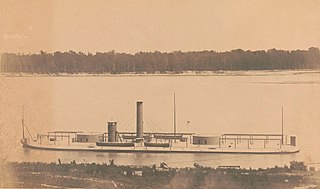
USS Chickasaw was an ironclad Milwaukee-class river monitor built for the United States Navy during the American Civil War. The ship participated in the Battle of Mobile Bay in August 1864, during which she was lightly damaged, and the bombardments of Forts Gaines and Morgan as Union troops besieged the fortifications defending the bay. In March–April 1865, Chickasaw again supported Union forces during the Mobile Campaign as they attacked Confederate fortifications defending the city of Mobile, Alabama.
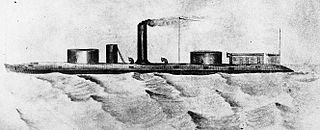
USS Winnebago was a double-turret Milwaukee-class river monitor, named for the Winnebago tribe of Siouan Indians, built for the Union Navy during the American Civil War. The ship participated in the Battle of Mobile Bay in 1864, during which she was lightly damaged, and the bombardments of Forts Gaines and Morgan as Union troops besieged the fortifications defending the bay. In early 1865, Winnebago again supported Union forces during the Mobile Campaign as they attacked Confederate fortifications defending the city of Mobile, Alabama. She was placed in reserve after the end of the war and sold in 1874.

Mobile, Alabama during the American Civil War was an important port city on the Gulf of Mexico for the Confederate States of America. Mobile fell to the Union Army late in the war following successful attacks on the defenses of Mobile Bay by the Union Navy.
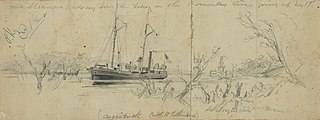
USS Currituck was a steamer acquired by the Union Navy for use during the American Civil War.

USS Octorara was a steamer acquired by the Union Navy during the American Civil War. She was used by the Navy to patrol navigable waterways of the Confederacy to prevent the Confederates from trading with other countries.
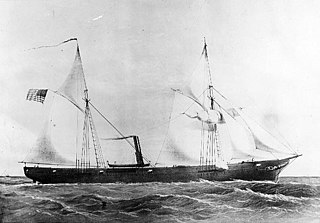
USS Kanawha was a Unadilla-class gunboat built for the Union Navy during the American Civil War. She was used by the navy to patrol navigable waterways of the Confederacy to prevent the South from trading with other countries.

USS Calhoun was a captured Confederate steamer and blockade runner acquired by the Union Navy from the prize court during the American Civil War.
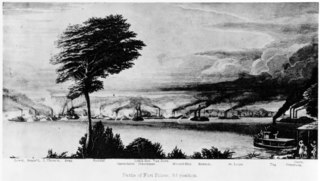
USS Sumter was a 525-ton sidewheel paddle steamer captured by the Union Navy during the Union blockade of the American Civil War.
Commodore Homer Crane Blake was a flag officer of the United States Navy, notable for his gallant but ultimately doomed battle with the CSS Alabama in his ship USS Hatteras in the action off Galveston Light during the American Civil War. He later served with distinction on the James River, and in 1871, while serving in the Asiatic Squadron, took part in the Korea Expedition.

Ebenezer Farrand was an American Commodore that served in the Confederate States Navy and was notable for his service at the Battle of Drewry's Bluff as well as his ship construction at Selma, Alabama.

The Huntsville-class ironclads consisted of two casemate ironclads ordered by the Confederate States Navy in 1862 to defend Mobile, Alabama, during the American Civil War. Completed the following year, they used propulsion machinery taken from steamboats, and were intended to be armored with 4 inches (102 mm) of wrought iron and armed with four cannons. Both CSS Tuscaloosa and her sister ship CSS Huntsville were found to be too slow for practical use, and were relegated to service as floating batteries. Union forces captured Mobile in April 1865, and the sisters were scuttled on April 12, as they were unable to escape due to an inability to steam against the current on the Spanish River.

















